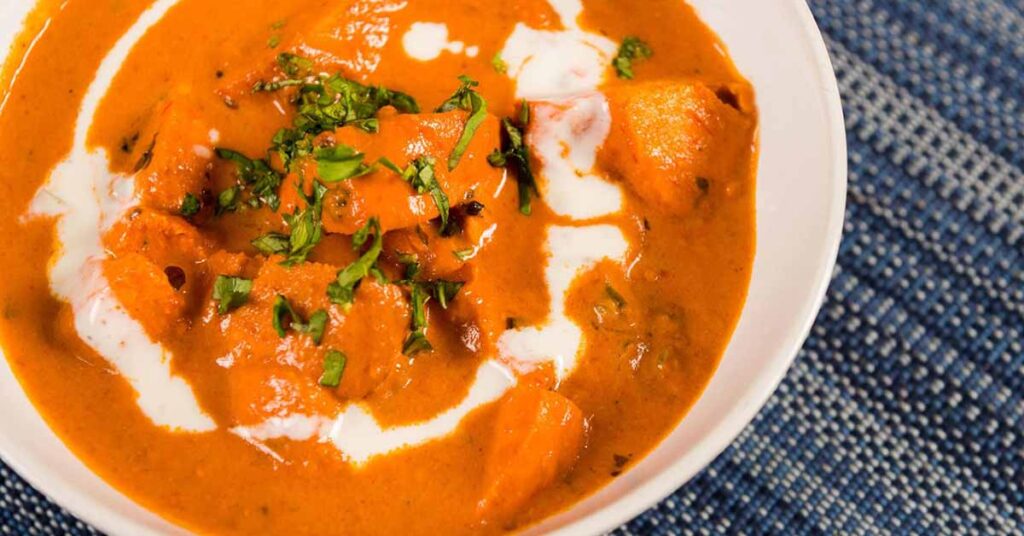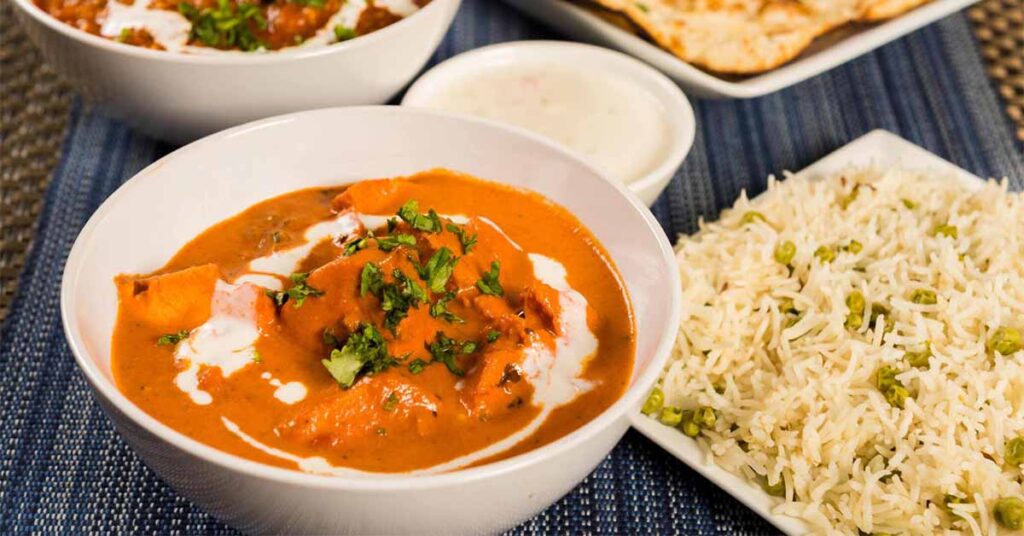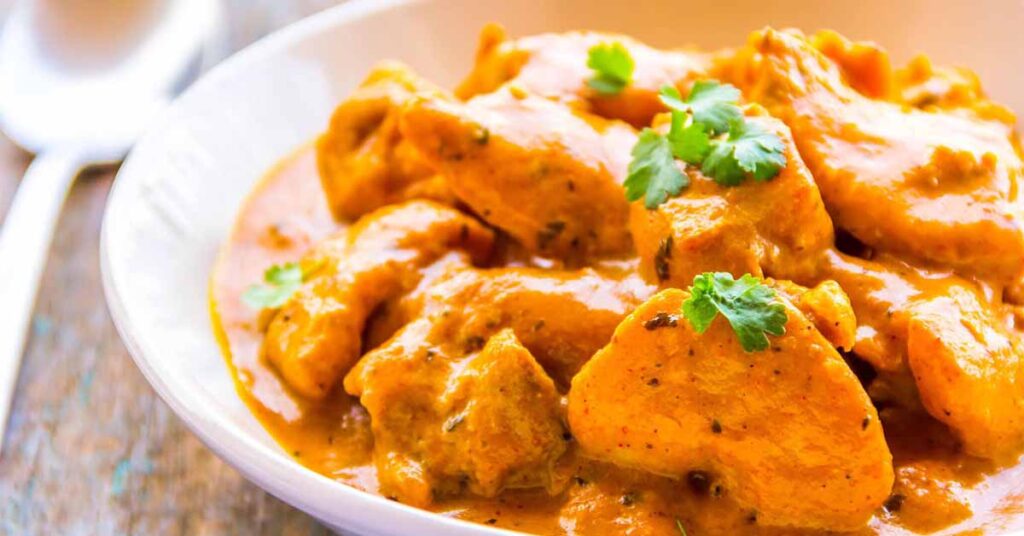Butter chicken, or Murgh Makhani, is more than just a dish; it’s a journey into the heart of Indian cuisine. This butter chicken recipe offers a creamy, tomato-based sauce combined with tender chicken pieces, creating an unforgettable culinary experience.
History and Origin of Butter Chicken
The story of butter chicken begins in the early 20th century in Delhi, India. Created by chance at the famous Moti Mahal restaurant, chefs combined leftover chicken with a rich tomato, butter, and cream sauce. This happy accident gave birth to a dish now beloved worldwide. Its roots reflect the essence of Indian innovation and culinary genius.

Popularity Globally
From its humble beginnings, butter chicken has soared in popularity, becoming a staple in Indian restaurants across the globe. Its universal appeal lies in its mild spice level and creamy texture, making it a favorite among both those new to Indian cuisine and seasoned spice enthusiasts. Today, it’s celebrated as a symbol of Indian culinary tradition on the international stage.
What Makes Butter Chicken Unique?
What sets butter chicken apart is its perfect balance of flavors. The dish combines garam masala, fenugreek, and other spices with the tanginess of tomatoes and the richness of cream and butter. This harmony of ingredients creates a comforting, yet exotic taste. Moreover, its versatility allows for various adaptations, catering to different dietary needs without losing its essence. Whether served with fluffy basmati rice or warm naan, butter chicken remains a testament to the richness of Indian cuisine.
For those eager to dive deeper into the world of Indian cooking, exploring the rich history of Indian cuisine offers a fascinating journey. Additionally, mastering the art of cooking basmati rice can elevate your butter chicken experience, ensuring every bite is as authentic as it is delicious.
In our journey through the world of butter chicken, we’ll explore not just its flavors but also the stories and techniques behind this beloved dish. Stay tuned as we delve into the ingredients, preparation, and the many ways to enjoy butter chicken in the sections to follow.
Ingredients and Substitutions for Butter Chicken Recipe
The success of any butter chicken recipe lies in its ingredients. From the juicy pieces of chicken to the rich, creamy sauce, every component plays a crucial role. For those exploring dietary alternatives, this butter chicken recipe can be adapted to suit vegan and dairy-free preferences without compromising on taste.

Ingredients for Butter Chicken
At the heart of butter chicken lies a symphony of ingredients, each playing a crucial role in crafting its signature taste. Let’s break down the main components:
- Chicken: The star of the dish, typically boneless and skinless, marinated in a blend of yogurt and spices, then grilled to perfection. The chicken pieces are succulent, absorbing the rich flavors of the sauce.
- Tomatoes: They form the base of the sauce, offering a tangy depth that balances the creaminess. Crushed tomatoes or puree work best, providing the sauce with its vibrant color and acidity.
- Cream: Adds a luxurious, velvety texture to the sauce, mellowing out the spices and enriching the dish’s overall flavor profile. Heavy cream or whipping cream is commonly used to achieve the desired consistency.
- Spices: The soul of butter chicken, including garam masala, fenugreek, turmeric, and cumin, among others. These spices are carefully measured to create a harmonious blend that defines the dish’s character.
Substitutions for Dietary Restrictions
For those with dietary restrictions or preferences, fear not. Butter chicken can be adapted to suit various needs without compromising its essence.
- Vegan Alternatives: Swap chicken for plant-based options like tofu or tempeh. These alternatives absorb the marinade well and offer a texture reminiscent of the original. For the sauce, use crushed tomatoes and coconut cream as the base, ensuring the dish remains vegan-friendly.
- Dairy-Free Options: Coconut cream or a rich, unsweetened almond milk can replace dairy cream, offering a similar creaminess with a subtle, nutty undertone. For the marinade, opt for dairy-free yogurt alternatives. This switch not only caters to dairy-free diets but also introduces a new dimension to the dish’s flavor.
These substitutions ensure that butter chicken remains accessible and enjoyable to everyone. Whether you adhere to a vegan lifestyle or navigate dairy intolerance, these alternatives promise a butter chicken experience that’s both inclusive and delightful.
By embracing these modifications, butter chicken transcends its traditional boundaries, proving that great flavors know no limits. Next, we’ll explore the step-by-step process of bringing these ingredients together to create the magic that is butter chicken. Stay tuned for a culinary adventure that promises to be as enriching as it is delicious.
Step-by-Step Cooking Guide for Butter Chicken Recipe
Preparing the marinade is the first step in bringing the butter chicken recipe to life. Whether you’re cooking the chicken on the stovetop or in the oven, achieving the perfect flavor and tenderness is key. This guide ensures your butter chicken recipe turns out perfect every time.

Preparing the Marinade
The journey to a mouth-watering butter chicken begins with the marinade, a crucial step that infuses the chicken with rich flavors and tenderizes it. Here’s how to prepare the marinade:
- Combine Yogurt and Spices: Start by mixing plain yogurt with a blend of spices including garam masala, turmeric, cumin, and chili powder. The yogurt acts as a tenderizer, while the spices impart depth and warmth.
- Add Ginger and Garlic: Incorporate freshly grated ginger and minced garlic to the mix. These ingredients add a kick and aromatic essence, essential to the dish’s complexity.
- Marinate the Chicken: Cut the chicken into bite-sized pieces for even cooking and flavor absorption. Coat the chicken thoroughly in the marinade, ensuring each piece is well-covered.
Marination Time and Tips
- Time: Ideally, let the chicken marinate for at least 4 hours, though overnight is best. This duration allows the flavors to penetrate deeply and the acids in the yogurt to tenderize the meat.
- Container: Use a non-reactive container or a zip-lock bag to marinate the chicken. This prevents any interaction between the marinade’s acidity and the container’s material.
- Refrigeration: Always marinate in the refrigerator to keep the chicken safe from bacterial growth.
Alternative Marinades
For those looking to explore beyond the traditional, here are a couple of alternative marinades:
- Coconut Yogurt Marinade: A dairy-free version that substitutes plain yogurt with coconut yogurt, offering a subtle sweetness and vegan-friendly option.
- Spicy Marinade: For those who favor heat, add extra chili powder or a spoonful of cayenne pepper. Adjust according to your spice tolerance.
Each alternative marinade offers a unique twist to the classic butter chicken, allowing you to customize the dish to your taste preferences. Experimenting with different marinades can lead to delightful discoveries, enriching your culinary repertoire.
Cooking the Chicken
Cooking Techniques: Stovetop vs. Oven
Once your chicken is marinated and ready to go, you have two primary methods to cook it: on the stovetop or in the oven. Each technique offers its unique texture and flavor to the chicken.
- Stovetop: For a quick and easy method, cooking the chicken on the stovetop is ideal. Simply heat a pan over medium heat, add a bit of oil, and place your marinated chicken pieces in the pan. The key here is to let them sear without moving them around too much at the start. This method creates a lovely char on the outside while keeping the inside juicy.
- Oven: Preheat your oven to 400°F (200°C). Arrange the chicken pieces on a baking sheet lined with parchment paper, ensuring they’re not touching. Roast for about 20-25 minutes, or until the chicken is golden and slightly charred at the edges. This method is great for a hands-off approach and can yield a drier, more concentrated flavor.
How to Know When Chicken is Cooked
Ensuring your chicken is cooked properly is crucial for both safety and enjoyment. Here are a few tips:
- Internal Temperature: The most reliable method is to use a meat thermometer. Chicken is safe to eat when the internal temperature reaches 165°F (74°C). Insert the thermometer into the thickest part of the chicken to check.
- Juices Run Clear: Another indicator is to look at the juices. When you pierce the chicken with a knife, the juices should run clear, not pink.
- Texture: Fully cooked chicken should feel firm to the touch and no longer jiggly or rubbery. If it’s still soft, it likely needs more time.
By mastering these cooking techniques and knowing how to determine when your chicken is perfectly cooked, you’re well on your way to creating a delicious butter chicken dish. Whether you choose the stovetop for its sear or the oven for its convenience, both methods can produce succulent chicken that’s ready to be smothered in that creamy, spiced tomato sauce.
Preparing the Sauce
The sauce is what truly defines butter chicken, enveloping the tender chicken pieces in a creamy, aromatic bath. Here’s how to craft this essential component:
- Sauté Onions and Tomatoes: Begin by heating a generous amount of ghee in a pan. Add finely chopped onions, cooking until they’re soft and translucent. Then, introduce crushed tomatoes or tomato puree, simmering until the mixture thickens slightly.
- Incorporate Spices: Now, stir in your core spices—garam masala, fenugreek, turmeric, and cumin. Allow them to cook with the onion-tomato mixture, releasing their flavors.
- Add Cream: Lower the heat before adding cream to avoid curdling. Stir well until the sauce achieves a uniform, creamy texture.
- Blend for Smoothness: For an extra smooth sauce, transfer the mixture to a blender and pulse until silky. Return it to the pan to keep warm.
Texture and Consistency Tips
- Thickness: The ideal sauce is thick enough to cling to the chicken but fluid enough to pour. If your sauce is too thin, simmer it for a few extra minutes. If it’s too thick, a splash of water or chicken broth can loosen it.
- Creaminess: Achieving the perfect creaminess is key. Full-fat cream contributes to the sauce’s rich texture. For a lighter version, half-and-half can be used, but the sauce will be less decadent.
Adjusting the Spice Levels
- Mild to Fiery: The beauty of butter chicken lies in its adaptability. Start with moderate amounts of spices and adjust according to taste. Remember, it’s easier to add more spice than to take it away.
- Balancing Flavors: If you’ve gone overboard with the heat, additional cream or a touch of sugar can help balance the flavors. Conversely, if the sauce needs more kick, a pinch of chili powder or cayenne pepper can elevate the heat.
By following these steps and tips, you’ll create a butter chicken sauce that’s rich, flavorful, and perfectly tailored to your taste preferences. The sauce not only complements the chicken but also becomes a delicious accompaniment to rice or naan, making every bite a delightful experience.
Combining Ingredients and Final Touches
Incorporating the chicken into the sauce is a pivotal moment in the butter chicken recipe. Finishing with cream and fenugreek not only adds depth to the dish but also ensures the butter chicken recipe has that signature richness and aroma.
Incorporating the Chicken into the Sauce
Once your chicken is perfectly cooked and your sauce has reached the ideal consistency, it’s time to marry the two. Gently add the chicken pieces into the simmering sauce, ensuring each piece is well-coated. Let the combination simmer together for a few minutes. This not only allows the chicken to soak up the flavors but also ensures that the meat is tender and the sauce, richly infused with spices.
Finishing with Cream and Fenugreek
- Adding Cream: To finish, stir in a final splash of cream into the sauce. This last addition enhances the sauce’s richness and smoothness, giving it a luxurious texture that’s hard to resist. The cream also helps to mellow out the spices, ensuring the sauce has a balanced flavor profile.
- Sprinkling Fenugreek: Crush dried fenugreek leaves between your fingers to release their aroma, then sprinkle them over the sauce. Fenugreek, with its unique bittersweet notes, adds an irreplaceable depth to the dish, rounding out the flavors beautifully.
After incorporating these final touches, allow the butter chicken to simmer for a few more minutes. This brief cooking period lets the flavors meld together, ensuring every bite is infused with the dish’s signature taste.
Serving and Pairing
When it comes to serving the butter chicken recipe, pairing it with the right sides and beverages can elevate the dish to new heights. Whether it’s fluffy basmati rice or warm naan, the right accompaniments make the butter chicken recipe a meal to remember.

How to Serve Butter Chicken
Butter chicken is traditionally served hot, allowing the aromas and flavors to fully emerge. It’s typically presented in a deep bowl or dish, making sure the creamy sauce generously coats the tender chicken pieces.
Accompaniments: Rice and Naan
The perfect companions to butter chicken are fluffy basmati rice and warm naan bread. Basmati rice offers a delicate fragrance that complements the rich sauce, while naan bread is ideal for scooping up the creamy goodness, ensuring not a drop is wasted.
Garnishing Tips
A sprinkle of fresh, chopped cilantro not only adds a burst of color but also introduces a fresh, herbal note that cuts through the richness of the dish. A final drizzle of cream can enhance the visual appeal and add an extra layer of flavor. For a touch of brightness, a squeeze of lemon juice just before serving can elevate the dish’s overall taste.
Wine and Beverage Pairings
Non-Alcoholic Options
- Mango Lassi: This creamy, sweet, and tangy beverage complements the spicy and rich flavors of butter chicken beautifully.
- Sparkling Water with a Lime Wedge: Offers a refreshing and palate-cleansing effect between bites.
Wine Pairings
- Riesling: A slightly sweet Riesling can balance the heat and spices in butter chicken, with its acidity cutting through the richness.
- Gewürztraminer: This wine, known for its aromatic profile, pairs well with the complex flavors of Indian cuisine, matching the dish’s intensity.
Choosing the right accompaniments and pairings can transform the butter chicken experience, turning a simple meal into a memorable feast. Whether you opt for traditional sides or explore beverage pairings, the key is to complement the dish’s rich flavors and creamy texture.
FAQs
Addressing common questions about the butter chicken recipe helps ensure everyone can enjoy this dish to its fullest. From making it ahead of time to adjusting the spice levels, these tips make the butter chicken recipe accessible to all.
Can I Make Butter Chicken Ahead of Time?
Absolutely! Butter chicken actually tastes better the next day as the flavors have more time to meld together. Prepare the sauce and chicken as directed, then cool and store them in the refrigerator. When ready to serve, gently reheat on the stove, adding a little cream if the sauce has thickened too much.
Substitutes for Fenugreek Leaves
Fenugreek leaves, known for their unique flavor, can be hard to find. A good substitute is a mix of mustard greens and celery leaves, or a pinch of mustard seeds. These alternatives can mimic the slightly bitter and nutty taste of fenugreek leaves.
How to Store and Reheat Leftovers
Store leftovers in an airtight container in the refrigerator for up to 3-4 days. To reheat, place butter chicken in a saucepan over low heat, adding a splash of water or cream to adjust the consistency if needed. Stir occasionally until heated through. Avoid microwaving as it can unevenly heat and potentially spoil the texture.
Making Butter Chicken Less Spicy
If you prefer a milder version, reduce the amount of chili powder and garam masala in the recipe. You can also increase the cream or add a bit of sugar to the sauce to counteract the heat. Taste as you go to ensure the spice level meets your preference.


1 thought on “Butter Chicken Recipe: Perfect Every Time – Quick Tips”